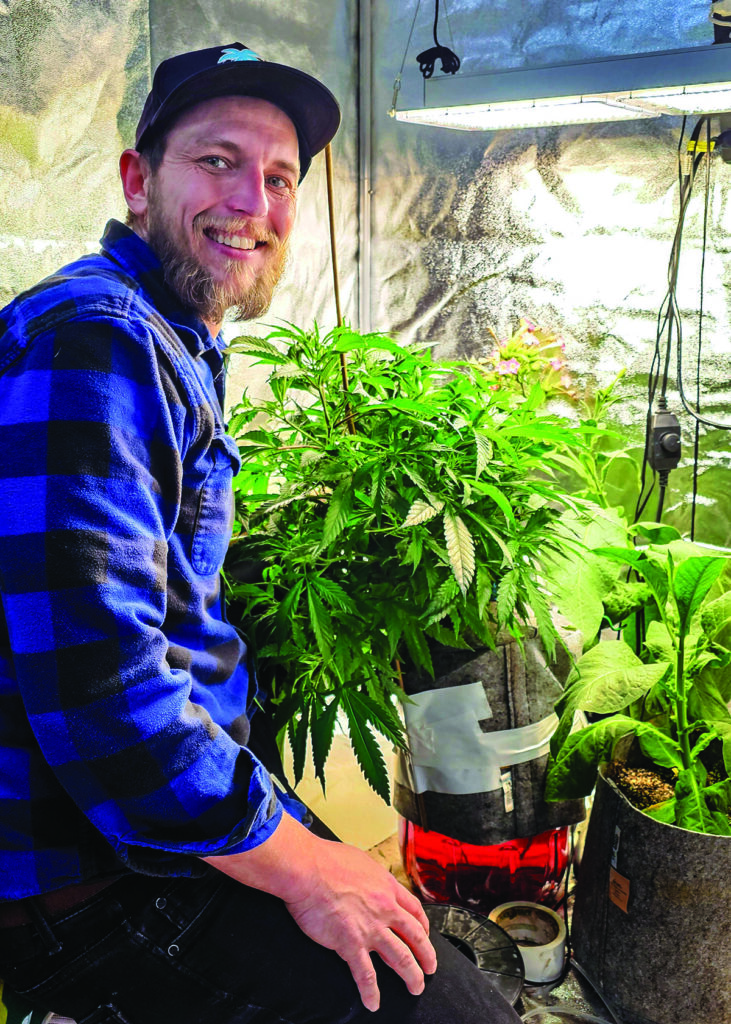
Steve Rosenfeldt is teaching Minnesota residents how to grow their own cannabis plants, providing seeds, potting soil, nutrients and other supplies in his Ediblez shop at 2223 Highway 10. (Photo/Nancy Hanson)
“Now that cannabis seeds are legal, I’m educating people on how to plant, care for and harvest them.” – Steve Rosenfeld
Nancy Edmonds Hanson
Minnesota’s legalization of recreational marijuana is on the brink of shaking up another fledgling industry – the sale of beverages and candies containing small dosages of hemp-derived THC.
Steve Rosenfeldt, the registered pharmacist who established Ediblez OTC in 2022, plans to apply for licensure to sell newly legalized cannabis products when the state’s rules are established. But that probably won’t happen until some time in 2025.
In the meantime, legalization has already affected his 18-month-old shop on Highway 10, as well as the three other Moorhead stores now selling THC and CBD products. Sales of edible products containing no more than 5 milliliters of the active ingredient – infused beverages, gummies, chocolates, mixers, crunch bars, bath bombs, salves, coffee and even dog chews – have begun to dip.
Why? Since Aug. 1, Minnesota residents over 21 have been permitted to grow up to eight marijuana plants for their personal use. And so, to balance out diminishing sales, Rosenfeldt is teaching those eager to cultivate cannabis to grow their own.
“My customers can have up to four mature flowering plants, and another four in the vegetative stage,” he says. “Now that cannabis seeds are legal, I’m educating people on how to plant, care for and harvest them.”
He has turned half of his Ediblez shop, next door to the Midtown Tavern, into a garden center of sorts. He cannot sell germinated plants. Instead, he provides a selection of 40 strains of cannabis seeds sold in packs of three. Most are hybrids of the two most popular varieties, Cannabis sativa and Cannabis indica, both native to Asia.
Each has its own strengths and advantages. One is size. Grown outdoors, sativa varieties develop into towering 12- to 15-foot plants with huge root structures. Indica strains are shorter and stockier. Their effects vary as well: “Sativa is more stimulating and energetic. Indica is relaxing and calming,” Rosenfeldt says. Some call sativa’s effects a “cerebral high,” uplifting and energetic; in contrast, indica produces a relaxing, calming “body high,” said to be effective for pain relief.
Ediblez’ stock includes everything the first-time grower needs to nurture rather finicky mini-crops of cannabis. The seeds are generally planted in buckets or sacks of special growing media, either soil mixtures or coco cori (fibers from the outer shell of coconuts), although hydroponic growing is also an option. Special fertilizers nurture the plants. Grow lights simulate sunshine for the greenery grown in basements. Grow tents – zipped enclosures that resemble portable fish houses – come equipped with both lights and an air exchange system to keep the plants’ distinctive odor under control.
Timing has so far dictated that most are growing their own greenery indoors. The law also permits outdoor growing on private property, but the area must be locked and shielded from public view.
Rosenfeldt has been holding monthly seminars on the final Saturday of the month for aspiring cannabis growers. “I had no idea what to expect at the first one in September. I thought maybe a handful would show up,” he says. “Instead, there were over 30. We’ve been getting 30 to 45 at every session,” with a core group of 10 or so attending regularly.
Who comes to learn to cultivate? “Most of them are over 50,” he reports. “We see both men and women, including some expert gardeners. The majority are looking for therapeutic applications rather than recreational marijuana. Quite a few have someone in memory care.” He adds, “For the most part, I think the younger generations find out what to do on the internet.”
Rosenfeldt estimates the cost of cultivating cannabis plants ranges from $300 for a small, simple set-up to $1,000 for a grow tent with all the trimmings. Sales, he suggests, have been brisk.
Legalization is sure to affect the new shops selling hemp-derived THC and CBD products that have sprung up in Moorhead and across the state, as well as medical dispensaries open only to those with medical marijuana cards. As state regulations shake out over the next 18 months, he expects most sellers to seek licenses to sell recreational marijuana. The state has estimated needing a retailer for every 12,500 of population; looking to the market just a river’s width away in North Dakota, Rosenfeldt expects to see a dozen here someday.
Cannabis sales were banned by the U.S. government in 1937. After 87 years of clandestine sales in the shadows, the outcome of Minnesota’s legalization is virtually guaranteed to be substantial, especially here on the border. “This is one of the few instances in any industry where Minnesota has an advantage over North Dakota,” Rosenfeldt points out. “It’s going to be massive.”


